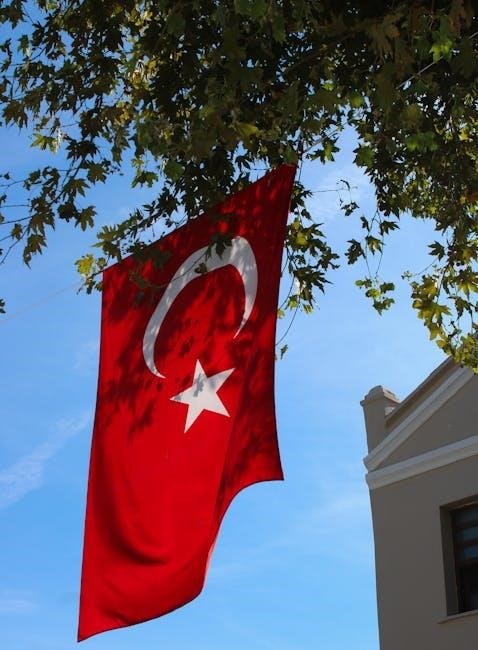The Sun Is Also a Star by Nicola Yoon is a captivating novel exploring love, fate, and cultural identity through the perspectives of Natasha and Daniel.

Overview of the Book
The Sun Is Also a Star by Nicola Yoon is a poignant and thought-provoking novel that intertwines the lives of Natasha, a science-driven girl facing deportation, and Daniel, a charismatic poet. Set in New York City, the story explores themes of love, fate, and identity through their unexpected encounter. The book delves into Natasha’s pragmatic worldview, contrasting it with Daniel’s romantic and artistic nature. Their journey raises questions about destiny, family, and cultural heritage. The narrative is enriched with non-linear storytelling and multiple perspectives, offering a deeper understanding of the characters’ motivations. Available in PDF format, the novel has gained widespread acclaim for its emotional depth and relatable themes, making it a popular choice for readers seeking a blend of realism and romance.
Author Background: Nicola Yoon
Nicola Yoon is a renowned author known for her heartfelt and thought-provoking young adult novels. Born to Jamaican parents, her experiences with cultural identity and immigration deeply influence her writing. Yoon’s work often explores themes of love, family, and self-discovery, resonating with readers worldwide. Her debut novel, Everything, Everything, was a critical and commercial success, establishing her as a prominent voice in contemporary young adult literature. Yoon’s writing is celebrated for its emotional depth, relatable characters, and nuanced exploration of complex issues. Her personal journey as a mother and wife also inspires her storytelling, making her a beloved figure in the literary world.
Publication Details and Editions
The Sun Is Also a Star was published in 2016 by Delacorte Press, marking Nicola Yoon’s second novel. The book is available in multiple formats, including hardcover, paperback, and e-book. The hardcover edition spans 384 pages, with an ISBN of 978-0-553-49668-0. A PDF version of the novel is widely accessible online, with platforms like PDFDrive and the Internet Archive offering free downloads. The book’s popularity has led to numerous reprints and international editions, ensuring its global reach. Its digital availability has further enhanced its accessibility, making it easy for readers to engage with Natasha and Daniel’s story in various formats. This versatility has contributed to its enduring appeal and widespread readership.

Main Characters and Their Development
Natasha, a pragmatic science lover, and Daniel, a poetic dreamer, navigate love, identity, and fate in New York City, each challenging the other’s worldview profoundly.
Natasha: The Science-Oriented Protagonist
Natasha is a pragmatic and science-driven teenager who relies on facts and logic. Facing her family’s deportation to Jamaica, she dismisses notions of fate or destiny. Her grounded perspective contrasts with Daniel’s poetic nature, creating a dynamic tension. Natasha’s character evolves as she confronts love and uncertainty, challenging her rigid worldview. Her story highlights the struggle between rationality and emotional vulnerability, making her a relatable and compelling protagonist.
Daniel: The Poet and Dreamer
Daniel is a creative and introspective poet, often lost in his thoughts and aspirations. Unlike Natasha, he believes in fate and destiny, viewing life through a lens of hope and possibility. As the dutiful son of Korean immigrants, Daniel struggles with familial expectations, seeking to carve his own path. His encounter with Natasha sparks a transformative journey, blending his romantic ideals with her practicality. Through his character, Yoon explores the tension between pursuing artistic passions and meeting familial obligations, making Daniel a deeply human and endearing figure in the story.
Minor Characters and Their Roles
Minor characters in The Sun Is Also a Star play pivotal roles in shaping the narrative and deepening the emotional landscape. Natasha’s family, including her parents and younger brother, are central to her deportation crisis, highlighting the stakes of her situation. Daniel’s parents, particularly his father, embody the pressures of cultural expectations and the immigrant experience. Other characters, such as Irene and the lawyer, provide critical plot points and emotional support. These secondary figures not only advance the story but also enrich the themes of family, identity, and resilience. Their interactions with Natasha and Daniel underscore the complexity of their journeys, making the novel feel deeply layered and authentic.

Themes Explored in the Novel
The Sun Is Also a Star delves into themes of love, fate, cultural identity, and family ties, contrasting science with art and exploring immigration struggles, creating a meaningful narrative.
Love and Its Various Forms
The Sun Is Also a Star explores love in its raw, spontaneous, and deeply human forms. Natasha, a pragmatic scientist, and Daniel, a romantic poet, embody contrasting views on love. Their chance meeting in New York City sparks a connection that challenges Natasha’s disbelief in fate and Daniel’s idealized notions of romance. The novel delves into familial love, selfless devotion, and the complexities of first love, weaving these themes with cultural and emotional depth. Through their stories, Yoon illustrates how love can be both a grounding force and a transformative experience, transcending logic and expectation. This exploration of love’s multifaceted nature resonates deeply, making it a central theme of the book.
Fate vs. Free Will
The Sun Is Also a Star delves into the tension between fate and free will, exploring how these forces shape the lives of Natasha and Daniel. Natasha, a pragmatic scientist, rejects the idea of fate, believing in the power of human agency and scientific certainty. In contrast, Daniel, a romantic poet, sees their meeting as destined, reflecting his belief in a universe guided by unseen forces. The novel examines how their choices and circumstances intersect, leaving readers to ponder whether their paths were predetermined or shaped by personal decisions. This theme is central to the story, highlighting the complexity of life’s unpredictability and the interplay between chance and control.
Cultural Identity and Family Ties
The Sun Is Also a Star explores the profound impact of cultural identity and family ties on its characters. Natasha, facing deportation to Jamaica, grapples with her Caribbean heritage and the pressures of belonging in America. Her family’s impending separation underscores the fragility of their cultural roots. Daniel, a Korean-American, struggles with his parents’ expectations, reflecting the tension between honoring tradition and forging his own path. The novel vividly portrays how these characters navigate their identities, blending personal aspirations with familial obligations. Through their stories, Yoon highlights the resilience of cultural heritage and the enduring bonds of family, even in the face of uncertainty and change.
Science vs. Art: Contrasting Perspectives
The Sun Is Also a Star delves into the contrasting perspectives of science and art through its protagonists, Natasha and Daniel. Natasha, a science enthusiast, relies on facts and logic, dismissing notions of fate or destiny. Her pragmatic worldview is rooted in empirical evidence, reflecting her desire to control her uncertain future. In contrast, Daniel, a poet, embraces creativity and emotional expression, finding meaning in the intangible and the beauty of human connection. Their differing perspectives create a dynamic tension, highlighting the complementary nature of science and art. The novel explores how these opposing views shape their understanding of the world and their places within it, ultimately revealing the interconnectedness of logic and emotion.
Plot Structure and Narrative Style
The Sun Is Also a Star features a non-linear narrative, blending multiple perspectives and voices to create a rich, layered story. The novel’s structure emphasizes emotional depth and thematic exploration through its unique storytelling approach.
Non-Linear Storytelling
The Sun Is Also a Star employs a non-linear narrative structure, weaving together past, present, and future events to create a dynamic and emotionally resonant story. The novel shifts seamlessly between the perspectives of Natasha and Daniel, offering a multi-dimensional exploration of their lives and experiences. This storytelling approach not only heightens the emotional impact but also underscores the themes of fate, identity, and the interconnectedness of human lives. By deviating from a traditional chronological order, Nicola Yoon crafts a unique reading experience that keeps readers engaged and invested in the characters’ journeys. The non-linear format adds depth and complexity to the plot, making it a standout feature of the book.
Multiple Perspectives and Voices
The Sun Is Also a Star is distinguished by its use of multiple perspectives, primarily alternating between Natasha and Daniel, but also incorporating minor characters. This narrative technique provides a rich, layered exploration of the characters’ thoughts, emotions, and backgrounds. Natasha’s pragmatic, science-driven worldview contrasts sharply with Daniel’s poetic and introspective nature, creating a dynamic interplay. Additionally, the inclusion of secondary characters’ voices adds depth, offering glimpses into their lives and motivations. This approach not only enhances the story’s emotional resonance but also underscores the novel’s themes of identity, family, and cultural heritage. The interwoven perspectives create a tapestry of experiences, making the narrative feel both personal and universal.
Symbolism and Metaphors
The Sun Is Also a Star is rich in symbolism, with the title itself evoking the idea of celestial wonder and the interconnectedness of life. The sun and stars serve as metaphors for hope, love, and the vastness of the universe, reflecting the characters’ journeys. Natasha’s scientific mindset contrasts with Daniel’s poetic nature, symbolizing the clash and harmony between logic and creativity. The novel also uses New York City as a symbol of diversity and opportunity, while the characters’ cultural backgrounds represent the complexity of identity. The recurring theme of fate vs. free will is symbolized through coincidences and choices, emphasizing the idea that life’s path is both unpredictable and shaped by human agency. These symbols weave together to create a profound exploration of existence and connection.

Cultural and Social Relevance
The Sun Is Also a Star addresses immigration, deportation, and cultural identity, reflecting the struggles of immigrant families and the complexities of belonging in a new society.
Immigration and Deportation Issues

The Sun Is Also a Star delves into the poignant realities of immigration and deportation, as Natasha’s family faces imminent deportation to Jamaica. This urgency shapes her pragmatic worldview, emphasizing science and facts over fate or destiny. The novel highlights the emotional and legal struggles immigrant families endure, exploring themes of belonging and identity. Natasha’s story reflects the broader societal challenges of navigating a system that often feels indifferent to individual lives. Through her journey, Yoon sheds light on the human cost of deportation and the resilience required to maintain hope in uncertain circumstances. The book serves as a powerful commentary on the complexities of immigration and its impact on families and communities.
Racial and Ethnic Diversity
The Sun Is Also a Star vividly portrays racial and ethnic diversity through its characters, particularly Natasha, a Jamaican-American girl, and Daniel, a Korean-American poet. The novel explores the richness of their cultural backgrounds, weaving in traditions, language, and family values that shape their identities. Natasha’s Jamaican heritage and Daniel’s Korean upbringing are central to their stories, highlighting the unique experiences of immigrant families. Yoon’s portrayal of these characters celebrates diversity while addressing the challenges of navigating multiple cultural identities. The book underscores the importance of embracing one’s roots and the beauty of a multicultural society, making it a powerful exploration of race, ethnicity, and belonging in contemporary America.
Socioeconomic Challenges
The Sun Is Also a Star delves into the socioeconomic struggles faced by its characters, particularly Natasha and her family, who are on the brink of deportation. Financial instability and the pressures of immigration loom large, shaping their decisions and aspirations. The novel highlights the difficulties of navigating a system that often seems stacked against them, emphasizing the emotional and psychological toll of economic uncertainty. Daniel’s character also grapples with societal expectations tied to his family’s economic status, particularly the pressure to pursue a lucrative career. Through these narratives, Yoon sheds light on the intersection of race, class, and opportunity, offering a poignant exploration of how socioeconomic challenges shape individual and familial futures. The book underscores the resilience required to overcome these obstacles, making it a relatable and impactful read for many.
The Book’s Reception and Reviews
The Sun Is Also a Star received widespread critical acclaim for its emotional depth and unique narrative style. Readers praised its relatable characters and thought-provoking themes, earning high ratings across platforms. The novel is often compared to Nicola Yoon’s other works, solidifying her reputation in young adult literature.
Critical Acclaim and Awards
The Sun Is Also a Star garnered significant critical acclaim for its poignant storytelling and exploration of complex themes. Nicola Yoon’s work was praised for its unique narrative style, blending multiple perspectives and voices seamlessly. The novel received the Michael L. Printz Award, recognizing its literary excellence in young adult literature. It also ranked highly in the Goodreads Choice Awards, further cementing its impact. Critics highlighted the book’s ability to balance emotional depth with philosophical questions, making it a standout in contemporary YA fiction. The novel’s success led to its inclusion in several “best of” lists, solidifying its reputation as a modern classic in the genre.
Reader Responses and Ratings

Readers have overwhelmingly praised The Sun Is Also a Star for its emotional depth and relatable characters. The book holds a 4.32/5 rating on Goodreads, with over 500,000 ratings, showcasing its widespread appeal. Many readers appreciated the novel’s exploration of love, identity, and fate, resonating deeply with its themes. The unique narrative structure, alternating between Natasha’s and Daniel’s perspectives, was particularly praised for its freshness and creativity. Fans of young adult fiction lauded the book for its realistic portrayal of teenagers navigating complex emotions and societal pressures. While some found the non-linear storytelling challenging, the majority celebrated its originality and impact. The novel’s ability to spark meaningful discussions has made it a favorite among book clubs and individual readers alike.
Comparisons with Other Works by Nicola Yoon
Nicola Yoon’s The Sun Is Also a Star shares thematic similarities with her other works, such as Everything, Everything and Instructions for Dancing. Like these novels, it explores themes of love, identity, and family, but with a unique focus on fate and cultural heritage. While Everything, Everything centers on isolation and first love, The Sun Is Also a Star delves deeper into existential questions and societal pressures. Instructions for Dancing, though more introspective, mirrors Yoon’s ability to weave emotional depth into her stories. Fans of Yoon’s lyrical prose and nuanced character development will find The Sun Is Also a Star equally compelling, as it stands out for its dual perspectives and philosophical undertones.

Availability in PDF Format
The Sun Is Also a Star is widely available in PDF format on platforms like PDFDrive, Archive.org, and other digital libraries. Readers can download it for free or purchase through official retailers, ensuring accessibility for various e-readers and devices.
Downloading and Reading Options
Readers can easily access The Sun Is Also a Star in PDF format through platforms like PDFDrive, Archive.org, and other digital libraries. The book is available for free download, making it accessible to a wide audience. For e-readers, the PDF can be transferred to devices like Amazon Kindle by emailing the file or using the Kindle app. Tools such as CloudConvert can assist in converting the PDF to other formats like EPUB for compatibility with various readers. Additionally, platforms like Scribd and Google Books offer preview options for users to sample the content before downloading. This versatility ensures that fans of Nicola Yoon can enjoy the novel in their preferred format, whether on a computer, tablet, or e-reader.
Popular Platforms for Access
Tools for Converting and Reading
Several tools facilitate the conversion and reading of The Sun Is Also a Star in PDF format. CloudConvert is a popular option for converting EPUB files to PDF, ensuring compatibility with various e-readers. Kindle users can download the PDF directly or send it via email for seamless access. Calibre, a free e-book management software, allows users to convert and organize their library, making it easy to read the novel on multiple devices. Additionally, online platforms like Smallpdf offer quick conversion services, while Adobe Acrobat provides professional-grade tools for editing and reading PDFs. These tools enhance the accessibility and readability of the book for fans of Nicola Yoon.

Impact and Legacy of the Book
The Sun Is Also a Star has left a lasting impact on young adult literature, resonating with readers through its emotional depth and relatable themes, inspiring meaningful discussions and a loyal fan base.
Influence on Young Adult Literature
The Sun Is Also a Star has significantly influenced young adult literature by blending diverse voices, realistic themes, and poetic prose. Its exploration of love, identity, and immigration resonates deeply with readers, offering a fresh perspective on universal struggles. The novel’s non-linear narrative and multiple perspectives have set a new standard for storytelling in the genre. By addressing complex issues like deportation and cultural identity, Nicola Yoon has helped pave the way for more inclusive and thought-provoking YA fiction. The book’s success has also inspired a wave of novels focusing on marginalized voices, cementing its legacy as a groundbreaking work in contemporary young adult literature.
Adaptations and Future Prospects
While The Sun Is Also a Star has not yet been adapted into a film or series, its emotional depth and relatable themes make it a prime candidate for future adaptations. Its success in the young adult genre suggests that it could inspire a movie or TV series, bringing Natasha and Daniel’s story to a wider audience. Additionally, the book’s exploration of immigration, identity, and love could serve as a blueprint for future literary projects. Nicola Yoon’s unique storytelling style continues to influence writers, ensuring that the novel’s legacy will endure in the literary world. Its impact on young adult literature is likely to grow, inspiring new works that explore similar themes with authenticity and sensitivity.

Reader Communities and Discussions
Reader communities have embraced The Sun Is Also a Star, fostering vibrant discussions about its themes and characters. Online forums and social media groups dedicated to the book allow readers to share their interpretations and personal connections to Natasha and Daniel’s story. The novel’s exploration of identity, love, and cultural heritage resonates deeply, sparking debates about its relevance to contemporary issues. Fans often highlight the book’s emotional depth and its ability to inspire reflection on life’s uncertainties. The availability of the book in PDF format has further fueled its popularity, making it accessible to a global audience and encouraging wider participation in these discussions. This collective engagement underscores the novel’s enduring impact on readers worldwide.
